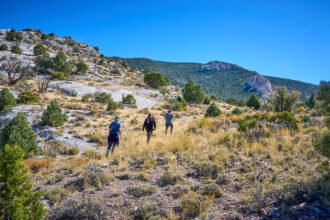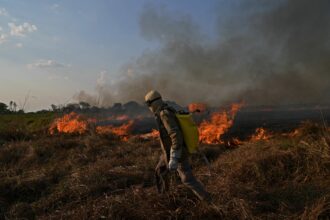One of our readers recently asked us if we might write something about war and climate. Many thoughts came to mind. The first: that the biggest wars are fought over the geopolitics of fossil energy, often in disguise. There’s also the Paris climate accord, which fails to require the reporting of military emissions in national greenhouse gas inventories: The rain of exploding bombs and missiles, the tanks and trucks that guzzle diesel, the fighter planes that burn jet fuel, the forward bases and supply lines that swallow gasoline by the tanker. As if they don’t count. It’s permission to continue waging war on the natural world, turning a blind eye to all the casualties of the future.
My mind was filled with these thoughts—and the constant news of unspeakable violence and human loss—when taking a day of rest, I had the privilege of going for a peaceful walk on the flank of Lenox Mountain in western Massachusetts. I went to a wildlife sanctuary, a place reserved for animals to be safe from humans. It was named Pleasant Valley of all things, and was tucked inside a wormhole, out of Internet range and all its amplified hatreds. The dull roar of distant roads, the numbing hum of human proximity—they do not invade the ether here either.
With ears wide open, I could suddenly see the place alive, its architecture of growth and decay constantly at play. Life emphatically itself, its many fallen trees the fertile ground of new beginnings.

Decades ago, I traveled the world with cameras, and now, dormant instincts long in hibernation bellowed back to life. All I had with me was an untethered, years-old smartphone. It would have to serve. Trail map in hand, I headed for the bottomlands and the beaver pond. The forest quiet filled with bug rhythm and bird call, leaf rustle and water spill. Loudest of all, though, was the clamor in my head, temporarily off the boil within this enclave but retaining great heat, like the planet.
Two degrees Celsius by 2050, leading to a catastrophic shutdown by century’s end of a vital ocean circulation. That’s what scientist James Hansen now expects, out on a limb again and generating controversy. Since the 1970s, his oracular talent has outpaced peer review. His fluency in earth history contains eons of vocabulary, timescales few can fathom. He carries the burden of deeply understanding what it means that carbon dioxide in our atmosphere has reached a level unseen in millions of years.
It’s foolish to bet against James Hansen, but our better judgment is easily ransomed for a gallon of gas, which provides energy equal to 400 hours of an adult’s labor. So, on a single day Earth sees the consumption of 100 million barrels of oil, our daily bonfire. Over 365 days it becomes a 36-billion-barrel conflagration whose economic value exceeds three trillion dollars.
We need a cease fire, but emissions targets designed to limit warming to 1.5- or 2.0-degrees Celsius stand little chance against unrelenting monetary forcing of such magnitude. Voluntary aspirations, inhabiting a universe of good intentions, remain divorced from the fossil fuel juggernaut heading our way in the decades ahead.
Zero carbon? Energy security? The global discourse gearing up for COP28 in the oil-rich UAE continues to speak with a forked tongue. It’s an apt phrasing, uttered originally in a native tongue to describe French colonizers, who in their war with the Iroquois would invite their enemies to a peace conference, only to slaughter them.
Ablaze with fall color, the woodlands generously cool off my brain on fire.

When the new October war in the holy land was barely two weeks old, the book trade in Frankfurt conferred a peace prize. Suffering its own casualty—an author it silenced—the city’s annual fair still managed to honor another—Salman Rushdie. He deployed his magical wisdom, his mythological imagination, to explain what the world of myth and fable has to say about peace. The news is not very good.
Homer tells us that peace comes after a decade of war, when everyone we care about is dead and Troy has been destroyed. The Norse myths, India’s Panchatantra, even the film Oppenheimer carry the same lesson. War is uncontrolled wildfire that stops when it burns out.
Peace is a hard thing to make, he said. And yet we yearn for it, not only the great peace that comes at the end of war but also the little peace of our private lives.
This day of sensory awakening in a quiet refuge, a little peace. It gave me to consider the Indigenous people who lived here for 10,000 years without waging war on the natural world.

William Cronon, whose seminal scholarship helped to launch the field of environmental history, explains that the Indians of New England, as he called them, did not stay put:
When fish were spawning many Indian families might gather at a single waterfall to create a dense temporary settlement in which feasting and celebration were the order of the day; when it was time to hunt in the fall, the same families might be found scattered over many square miles of land. All aspects of Indian life hinged on this mobility.
Once or twice a year they would burn the understory of their forests to keep them open and park-like, facilitating hunting and travel, speeding nutrient uptake of the soil, encouraging berries to proliferate. They created a patchwork of woodlands in different phases of succession, increasing the supply of herbivorous food which supported an even larger number of animals.
When the colonists arrived to find the forests teeming with game, the waters thick with fish, the sky dark with flocks of birds, they believed they had discovered a virgin land of plenty. They did not understand that for thousands of years Indigenous peoples had been carefully tending to the land and its trees, on close terms with the elk and the deer, the beaver, the hare and the porcupine, the turkey, the quail and the grouse, the bear and the moose, the eagle and the hawk, the lynx, the fox and the wolf.
Though their tenure on this land was long, Indigenous people kept their own populations in balance—at most 100,000 men, women and children lived across all of New England at any one time. In these parts they were Mohican, Lenape and Algonquian-speaking tribes. They remained in perpetual motion until a few hundred years ago when they were dispossessed and displaced, forced to settle down in faraway places. It’s hard to imagine what will be left of New England 10,000 years from now.

In 1642, soon after the colonists arrived, a Narragansett sachem named Miantonomo could already see what was coming.
Our fathers had plenty of deer and skins, our plains were full of deer, as also our woods, and of turkeys, and our coves full of fish and fowl. But these English have gotten our land, they with scythes cut down the grass, and with axes fell the trees; their cows and horses eat the grass, and their hogs spoil our clam banks, and we shall all be starved.
Miantonomo called upon Native peoples to unite – so must we be one as they are, otherwise we shall be all gone shortly – and finally he even proposed to ambush the colonists to be rid of them. He met his end by assassination. By 1800, Indigenous people like him could no longer travel their lands through the seasons as they always had.
The old forest and its native peoples were long gone when Pleasant Valley was incorporated as a wildlife sanctuary in 1928. It was farmland that came to somehow belong to the Power and Crockett families – orchards, fields, stone walls and pastures for a hundred head of stock. Over the century since, new forest has reclaimed the cleared lands, and beavers, reintroduced in 1932, have transformed the alder swamps into a pond. Today the place has become a beloved part of the local spiritual economy, maintained by Mass Audubon.

What’s also become part of the sanctuary are ornamental plants, which reached the continent from Asia in the 19th century. Meant to grace residential gardens with their spectacular fall colors, they proliferated aggressively and now crowd out native species—displacing and dispossessing them—mirroring human habit.
Dense, prickly thickets of the Japanese barberry offer a breathtaking sight indeed—a little peace—and also a blood-red reproach. As you walk past, spiny branches reach out to tug at your skirt, your pants, your leg—and at memory and conscience—insistently whispering the lesson of humility to a world on fire.













